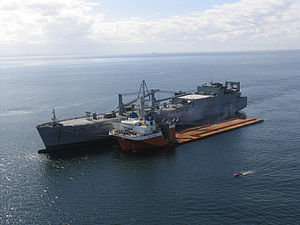This is an old revision of this page, as edited by Saberwyn (talk | contribs) at 02:26, 13 January 2011 (copyedit and tweaks, save progress). The present address (URL) is a permanent link to this revision, which may differ significantly from the current revision.
Revision as of 02:26, 13 January 2011 by Saberwyn (talk | contribs) (copyedit and tweaks, save progress)(diff) ← Previous revision | Latest revision (diff) | Newer revision → (diff) USNS Watkins (back) and heavy lift ship MV Mighty Servant 1 moor side-by-side off San Diego during a Mobile Landing Platform demonstration. USNS Watkins (back) and heavy lift ship MV Mighty Servant 1 moor side-by-side off San Diego during a Mobile Landing Platform demonstration.
| |
| Class overview | |
|---|---|
| Builders | General Dynamics |
| Operators | United States Navy |
| Planned | 3 |
| General characteristics | |
| Displacement | 34,544 metric tons (33,998 long tons; 38,078 short tons) |
| Length | 800 feet (240 m) |
| Speed | 20 knots (37 km/h; 23 mph) |
| Range | 9,000 nautical miles (17,000 km; 10,000 mi) |
| Troops | 1,112 marines |
| Complement | Unknown |
| Aviation facilities | 1 x VERTREP |
The Mobile Landing Platform is a class of amphibious assault ship currently being planned for the United States Navy, with the first ship due to launch in 2015. It will act as a staging position between large cargo ships and the smaller craft, such as LCACs, which are designed to land directly on beaches, and will be based loosely on the design of the Alaska class oil tanker.
Design
The proposed ships will have a displacement of 34,544 metric tons (33,998 long tons; 38,078 short tons) and a length of 800 feet (240 m). They will be capable of sailing at 20 knots (37 km/h; 23 mph), with a maximum range of 9,000 nautical miles (17,000 km; 10,000 mi). Although the size of the ship's crew is unknown, the vessels will be capable of hosting 1,112 marines and their equipment.
The class will be based around the idea of 'seabasing', where US troops would be based aboard the ship. Because of this, the ship is expected to be fitted with the ability to land helicopters, and to transfer large amounts of cargo and vehicles from its hold to another vessel berthed alongside. This will be accomplished using a simple ramp system which can be used in calm seas. It will not be able to operate in rough seas, or in areas where there are hazards to large shipping, such as mines or underwater obstacles.
The Mobile Landing Platform will also include ample space for the equipment used by troops aboard, including jeeps, helicopters, and mobile assault vehicles. It may also be able to accommodate future high-speed beach landing craft, currently being planned by the US Navy. Using the ship, a US Stryker brigade could be deployed to a hostile country within a few days, including the 15,000–20,000 tonnes (15,000–20,000 long tons; 17,000–22,000 short tons) of equipment needed to support such a brigade.
Testing
The navy tested the concept of a Mobile Landing Platform with USNS Red Cloud and MV Mighty Servant 1 off the coast of San Diego in 2010.
Construction
In August 2010, General Dynamics in San Diego was awarded a US$115 million contract to design the Mobile Landing Platform, and build the first ship. Construction is due to begin in July 2011. The United States Navy initially plans to acquire three vessels, with the first operational by 2015.
References
- ^ "The US Navy's Mobile Landing Platform Ships". Defense Industry Daily. Watershed Publishing. 18 August 2010. Retrieved 12 January 2011.
- ^ "GlobalSecurity.org". Retrieved 11 January 2011.
- Robbins, Gary (14 August 2010). "General Dynamics gets $115M for 'pier at sea'". San Diego Union-Tribune. The San Diego Union-Tribune, LLC. Retrieved 10 January 2011.